How B2B marketers are using data to segment email campaigns
Ever feel the pain of seeing low open rates after sweating over an important email marketing campaign? It's tough to get email right. "The fact is, most marketing teams put an enormous amount of time and energy into email marketing and still aren’t getting a meaningful bump in new customers," as Anna Jacobsen, Head of Customer Success & Onboarding at YouCanBook.Me, observes in her chapter on email personalization in our Data-Driven Marketing book.
Anna's right. Email campaigns that aren't personalized to feel more specific and relevant to recipients waste time and leave money on the table. Consumers today generally expect some degree of personalization and yet a whopping 75% of customers in North America say that they're not getting email content that speaks specifically to them.
At the very least, we should all be using data to segment our email recipients. And to better understand how marketers use data in their email marketing strategies for segmentation and metrics, we surveyed 113 marketers in November 2017.
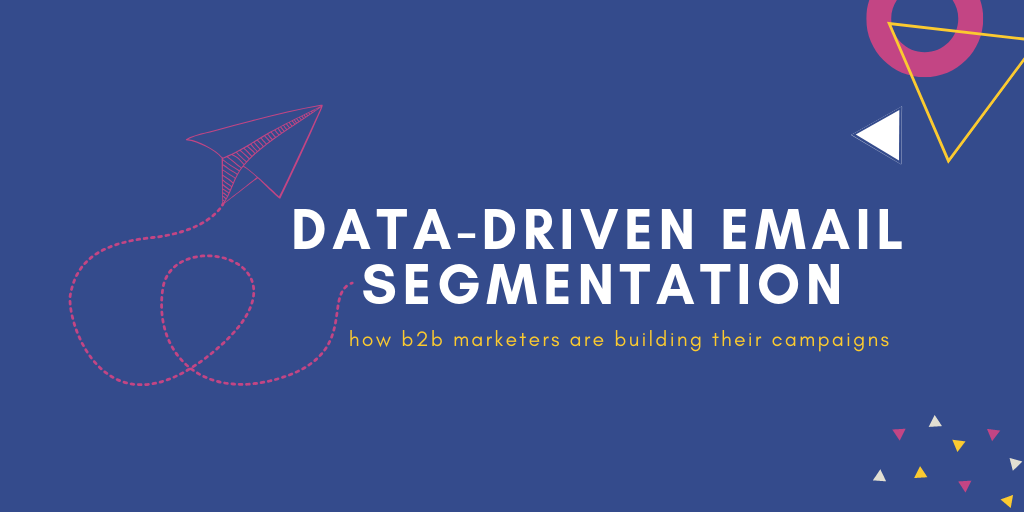
We asked these four questions:
- What parameters do you use to segment your email lists?
- What engagement behaviors do you use to segment your email lists?
- What email marketing metrics do you track?
- What email marketing metrics are the most meaningful for your business?
In our analysis, four key data trends emerged. Here's we learned, along with suggestions about how you can use this information to build more successful and effective email marketing campaigns.
Key Finding #1: Everybody segments their email lists
When marketing platform GetResponse ran a similar survey back in 2015, they found that only 58% of marketers in their survey were using segmentation. Two years later, we saw that every single one of our respondents segments their email lists. (Note that most of our respondents worked at B2B and/or SaaS companies, while 20% of GetResponse's respondents were online businesses.)
We found that the majority of marketers segment along more than one dimension:
- 56% of marketers are using more than 3 segmentation dimensions in their email marketing.
- 44% are using just 1-2 segmentation parameters.
In a few outlying cases, marketers used seven or more parameters to segment their lists.
Segmentation doesn't need to be complicated though. You can start by simply dividing people based on the most basic attributes or actions, such as whether they made a purchase or subscribed to your blog.
What you can learn from this
-
If you don't segment, it's time to start! Hop aboard the segmentation train if you haven't already. Defining who is getting what message is the ignition key to personalizing your messaging, improving campaign performance, and driving conversions.
-
Use multiple parameters to segment your email lists. As your business grows, your need for multiple conditions and parameters for segmentation will also grow. It's likely you'll want to segment your recipients in various ways — across their lifecycle, as they have different needs at different points of their customer journeys — or for different products and personas.
Key Finding #2: Email engagement behavior is the segmentation leader
Most marketers in our survey segmented their email subscribers and lists based on email engagement behavior.
Firmographic segmentation comes in just behind email engagement behavior, with 50% of respondents using attributes like company size, industry, and revenue to define their email lists.

Tied at 42% were parameters directly related to sales and marketing: sales-qualifying data points and buyer personas. Close behind at 40% percent is lead score. The fact that 58% of marketers don't use buyer personas is surprising, as this approach to segmentation has proved successful. When Brennan Dunn, founder of Double Your Freelancing, used buyer personas to personalize the company's nurture email campaigns, conversions increased by 250%.
The least popular ways to segment email lists were demographic data, referral source, and in-app engagement behavior.
What you can learn from this
-
Gauge interest level with email behavior segmentation. Email engagement is an easy way to segment your email lists, as most platforms have this type of segmentation baked in as an option. If, for instance, a customer is regularly engaging with your outbound marketing campaigns by clicking on your email call to action, then there is reason to believe that they are more interested in your company or your product than someone who has never opened any of your emails.
-
If you offer multiple products or various plan levels for a product, segment by firmographic data. This can help you determine which products or plans you should highlight for different audiences. For example, the video-conferencing company Zoom has several different plans to choose from. In their emails, Zoom could use firmographic data like employee count and revenue to determine the size of a company and make a personalized recommendation about which plans is the best fit.
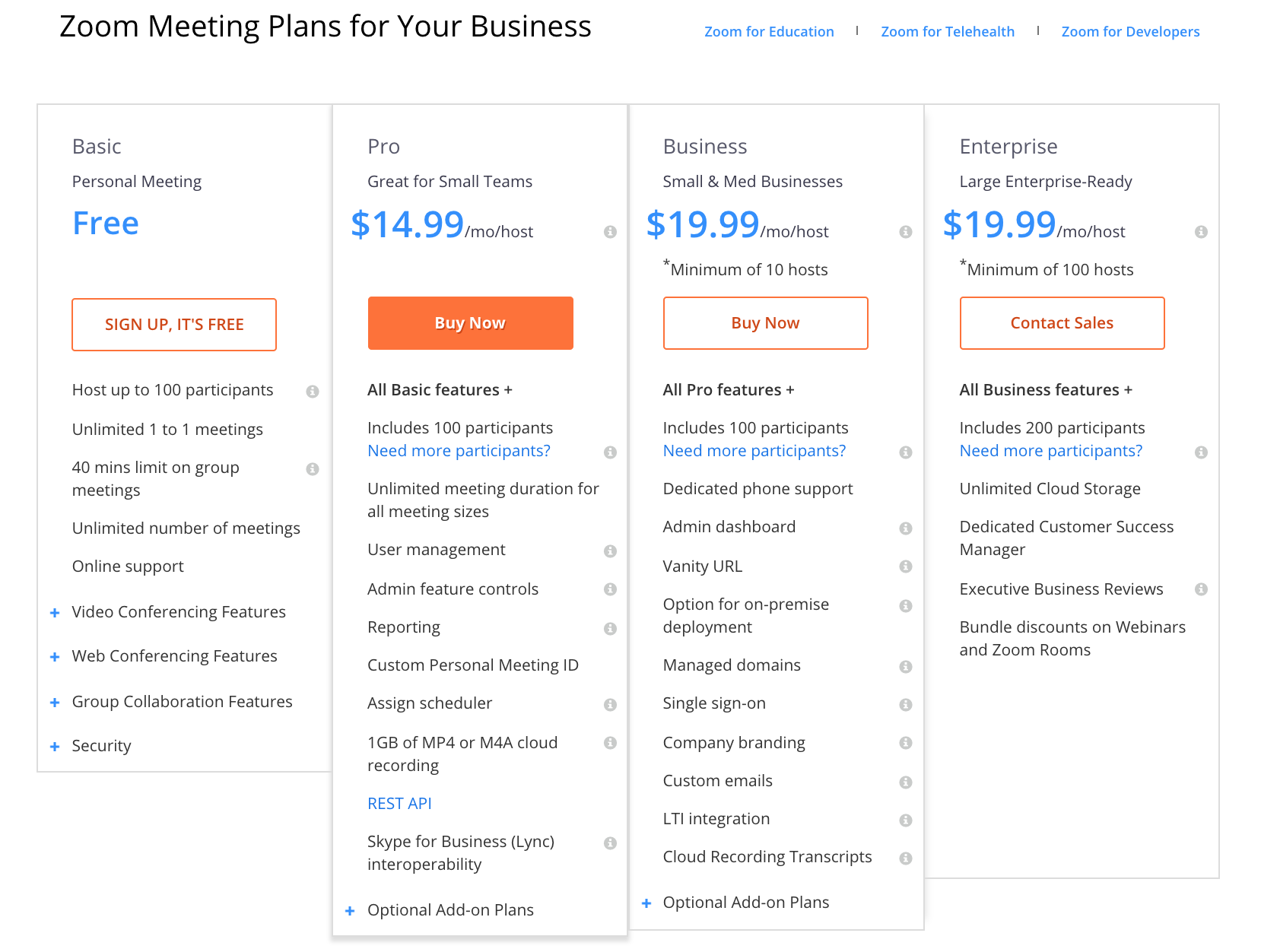
- Firmographic data is useful for data-driven sales emails. If you're a B2B business, company-level information should be your bread and butter for driving conversions. Using firmographic data, you can even automate sales campaigns to deliver targeted emails to your prospects, such as a tech-related email content to tech companies, media-related content to media companies, and so on. Shown below is an email that an SDR might send to a high-value prospect. Segment automated this message to a specific audience and further tailored the message based on the recipient's company information (industry and tech tools used).

-
Buyer personas are valuable for segmentation — use them! These are defined so that sales and marketing can tailor messaging to different customers. If marketers aren't using these during campaigns, it's a missed opportunity.
-
Use demographic data relevant to your leads and customers. For B2B companies, age and gender aren't as useful segmentation conditions as for retail and e-commerce businesses. But individual attributes such as location, role, and job title can completely be used as segments. We do this in our own welcome campaign for new customers, where the first emails are segmented based on whether a person's role is in sales, marketing, or engineering.
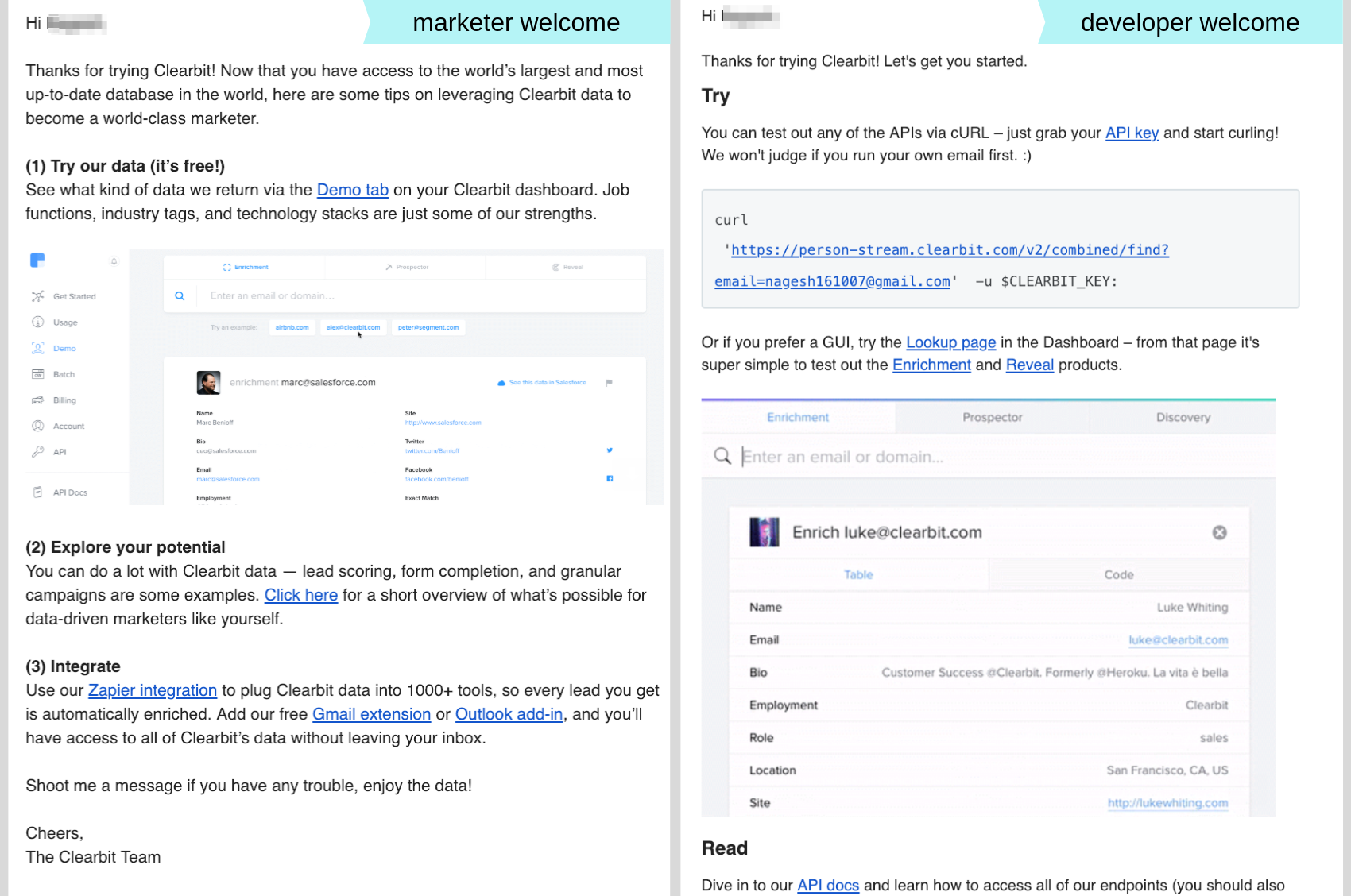
Key Finding #3: Most marketers segment customers by website engagement
We dug further into engagement-based segmentation by asking people to clarify which behaviors across their website, app, emails, and sales process they used.
By and large, most marketers in our survey segmented email lists based on website behavior. Specifically, they looked at whether a visitor
- downloaded content (44% of companies used this parameter);
- visited or engaged with the website (42% of companies used this parameter); or
- subscribed to the blog or other web content (39% of companies used this parameter).
This is unsurprising because website engagement is often the trigger for email nurture campaigns.
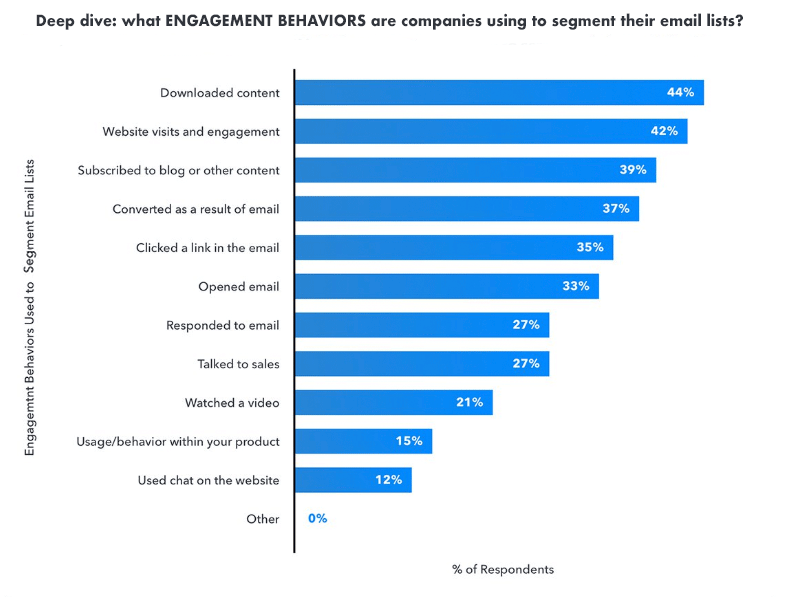
For example, if a lead downloads a piece of content from your site, you segment them onto a list related to that content. When you download a chapter from Amplitude's product analytics playbook, you get a follow-up email encouraging you to read other chapters or share the playbook on social.

You can segment your email list even further based on what links people click on — and then send the most relevant content or help move specific audiences closer to conversion. This is a great method as a fallback or if you're missing data about personas or attributes. For example, if your product serves product managers and UX designers, you can drop people into PM or designer tracks in response to what category of links they click on in a welcome series.
Email engagement was the second most popular way to segment email lists, taking up the next four positions on our list:
- 37% of companies are using email conversions to segment
- 35% of companies are using email clicks to segment
- 33% of companies are using email opens to segment
- 27% of companies are using email responses to segment
What you can learn from this
-
Don't ignore in-app, in-product, or other event data. Right now, only one in five marketing teams are segmenting on in-app behavior. This is a hugely underutilized opportunity, especially for B2B marketers. Email behavior is just the first level of behavioral data available for segmentation. While that may be best for top-of-funnel lead generation and lead nurture campaigns — when you get further along, in-product behavior and other key conversion actions are events that provide stronger signals of interest and engagement.
-
Create email campaigns based on site engagement. Follow up on user behavior when possible, including website interactions. Your content marketing should have an email component to nurture and convert. If you can tell that someone who downloaded your white paper recently has also visited your pricing page and a case study, it's probably a great time to reach out.
-
Implement a strategy for your disengaged audience. Tracking email behavior gives you data to identify areas for improvement. Are your unengaged email cohorts active leads and customers? Then maybe your email content needs revamping. Is lack of email engagement symptomatic of deeper customer journey disengagement? Then handle engaged and unengaged cohorts differently with messaging, tactics, and testing tailored to level of interest.
Key Finding #4: Clicks and opens are the marketer's metrics of choice
To optimize data-driven email campaigns, you need to track performance. For the most part, marketers are using two conventional tracking statistics to determine success: click-through rate and open rate. This finding isn't groundbreaking — most email marketing tools let you track these engagements straight out of the box. In fact, from the graph below, it's clear there are three bands of metrics:

The first band: click-through and open rates.
The second band comprises the bulk of metrics used in email marketing by approximately half of our respondents. These metrics are:
- Unsubscribe rate
- Subscriber growth
- Response rate
- Conversion attributed to various email campaigns
- Bounce rates
- Conversion attributed to email as an overall channel
- Email engagement scores
The third band has three metrics that were just seldom used for tracking marketing emails:
- Spam flags
- Earnings per click/email
- Share rates
The survey showed mixed results on tracking the efficacy of email marketing. On the one hand, many marketers are tracking conversions from emails, either on the whole or at the campaign level. On the other, actual revenue tracking was one of the least commonly tracked metrics at just 7%. This suggests that most marketers struggle to articulate how email is contributing in terms of return on investment.
We dove deeper into this to see whether these metrics were also being used proactively in business decisions. Turns out, they were.
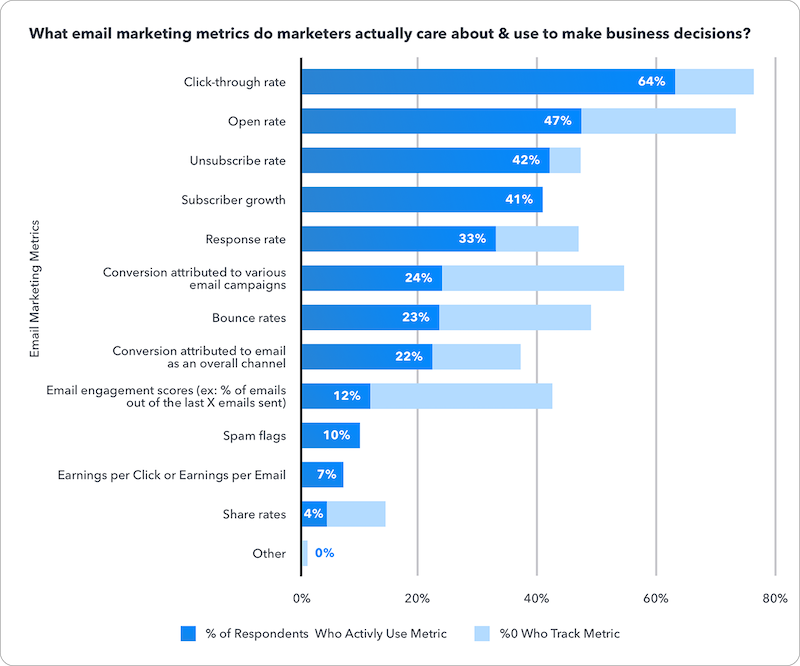
While click-through and open rates were still the most actively used, not everyone tracking was basing their business decisions on these metrics. Proportionally, subscriber information was the most actively tracked and meaningfully used.
There's a disconnect between tracking and then using this data to inform business decisions. When we asked respondents to expand on the dichotomy here, we found that they knew they should be tracking these metrics but were having trouble producing actionable data. For most, this came down to tools and resources. Marketers may not have the data-crunching abilities on hand or the time they need to surface these insights. And it's common at large companies to be locked into legacy enterprise platforms and unable to take advantage of more nimble SaaS email tools available for data flow, segmentation, and tracking.
What you can learn from this
-
Be wary of vanity metrics. Some of the most widely used email metrics, by themselves, can become "vanity metrics," meaning they can look good but don't actually provide helpful insights into what's going on with your campaign or business. Treat open rate and click rates more like engagement health indicators rather than the end-all results of an email campaign.
-
Keep an eye on spam flags. Only 14% of our survey respondents looked at spam flags. If you want to avoid ruining your domain sender score, you need to track your spam rate and make sure you are not getting flagged.
Main Takeaway
If you're focusing your energy on one-size-fits-all emails and expecting them to win over all of your leads, it's time to switch up your email marketing strategy.
The future of email marketing lies in thoughtful personalization. Creating more specific and relevant emails through smarter segmentation allows you to reach just as many people but with clearer messaging and more consistently throughout their customer journeys.
Learn more about email segmentation and personalization tactics in our Data-Driven Marketing chapter: Personalized Drip Sequences.

